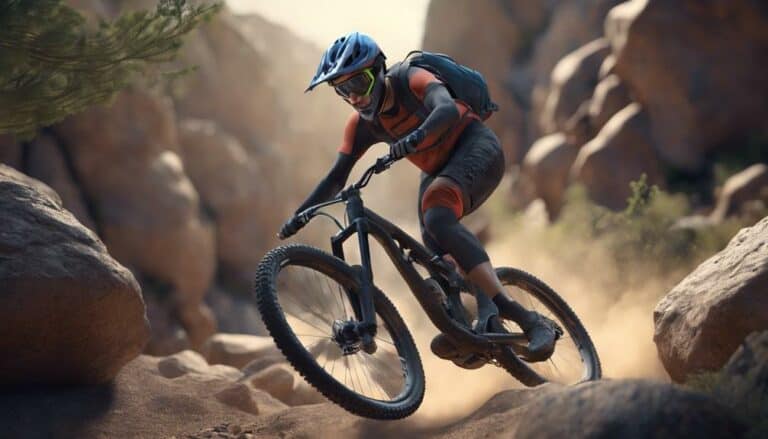When tackling rough terrain on your bike, maneuvering the bumps and twists is like dancing with the elements. But how can you guarantee you glide through it smoothly and safely?
The answer lies in mastering the key principles for maintaining proper body positioning. By understanding these fundamentals, you'll be equipped to conquer challenging landscapes with confidence and finesse.
So, let's uncover the secrets to enhancing your riding skills and conquering rough terrains with ease.
Key Takeaways
- Relax grip and stay loose for better control and shock absorption.
- Shift weight rearward and stand on footpegs to enhance stability.
- Anticipate rough patches and adjust body position for smoother rides.
- Use body as a shock absorber with correct weight distribution for improved maneuverability.
Importance of Proper Body Positioning
Proper body positioning on rough terrain is essential for maintaining stability, control, and overall safety while cycling.
When riding over challenging landscapes, your body position plays a critical role in ensuring a smooth and secure journey. By adjusting your body position, specifically focusing on weight distribution over the footpegs, you can greatly enhance traction and balance.
This is important for maneuvering unpredictable terrains where maintaining control is paramount.
Key Principles for Rough Terrain Riding
To excel in rough terrain cycling, mastering key principles is fundamental for enhancing your riding experience and safety. Riding over rough terrain requires a combination of skill, technique, and anticipation. By maintaining the correct body position, you can navigate challenging landscapes with greater control and confidence. Here are the key principles to keep in mind:
| Key Principles | Description |
|---|---|
| Relax Grip | Allow the bike to move freely under you by maintaining a relaxed grip. |
| Stay Loose | Keep your body loose and flexible to absorb shocks from uneven surfaces. |
| Shift Weight Rearward | Prevent the front end from diving by shifting your weight to the rear. |
| Stand on Footpegs | Improve control and act as additional suspension by standing with bent knees. |
| Anticipate Rough Patches | Look ahead and anticipate rough patches to adjust your body position preemptively. |
Techniques for Maintaining Correct Position
When traversing rough terrain on your bike, it's vital to employ specific techniques to maintain the correct body positioning for best control and stability. Here are some key techniques to help you navigate rough terrain effectively:
- Shift your weight back: By slightly shifting your weight towards the rear of the bike, you can maintain traction and stability, especially when riding over uneven surfaces.
- Lean forward: To keep your weight over the front wheel for better control and steering on rough terrain, lean forward slightly while maintaining a good body position to tackle obstacles confidently.
- Use your body as a shock absorber: Keep your elbows bent and relaxed to absorb shocks and vibrations. Additionally, bend your knees and stay loose in the saddle to effectively absorb shocks through your legs, aiding in maintaining balance.
- Maintain a firm grip: Guarantee stability and maneuverability by maintaining a firm grip on the handlebars, especially when riding at high speeds over bumps and obstacles.
Common Mistakes to Avoid
Leaning back excessively on rough terrain can result in a loss of control and traction, making it a significant mistake to avoid during off-road cycling. When riding over bumpy surfaces, leaning forward is key to maintaining a good body position. By doing so, you distribute less weight on the rear wheel, allowing for better traction and steering control. It's important to avoid leaning back as it can cause the front wheel to lift off the ground, leading to instability and potential accidents.
Another common mistake to steer clear of is failing to move fluidly with the terrain. Stiffening up your body won't only make the ride uncomfortable but also hinder your ability to absorb shocks and maintain balance. Remember to stay relaxed and let your body act as a shock absorber. Additionally, gripping the handlebars too tightly can impede your maneuverability. Keep a firm but relaxed grip to make you can adjust your position and navigate obstacles smoothly. By avoiding these common mistakes, you'll be able to ride over rough terrain with greater ease and control.
Benefits of Proper Body Alignment
Maintaining proper body alignment while cycling over rough terrain is important for ensuring balanced weight distribution and improved control. Here are the benefits of proper body alignment:
- Enhanced Shock Absorption: Correct alignment allows your body to better absorb the impacts of uneven terrain, reducing jolts and vibrations transmitted to your body.
- Best Weight Distribution: Proper alignment helps evenly distribute your weight on the bike, enhancing stability and preventing sudden shifts that can lead to accidents.
- Improved Visibility: By aligning your body correctly, you can see obstacles ahead more clearly, giving you time to react and adjust your course.
- Improved Maneuverability: Maintaining the right body position improves your ability to steer, turn, and navigate obstacles with precision, increasing your overall control over the bike.
Conclusion
You've learned the key principles for maintaining proper body positioning when riding over rough terrain.
Remember to keep your body as an extension of the machine, maintain correct knee and foot placement, and make sure your weight is forward with your weight over the footpegs.
By following these techniques, you'll feel like you're floating on air as you effortlessly navigate through challenging terrain with ease and confidence.
Ride on, fearless adventurer!

